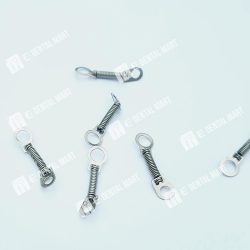Description
🦷 Uses of Torque Springs in Orthodontics:
-
Torque Adjustment for Molars and Premolars:
-
Corrects the angulation of molars and premolars, particularly when the teeth are tipped too far forward (labial) or backward (lingual).
-
-
Control of Tooth Movement:
-
Helps control buccal-lingual movement (movement toward or away from the tongue/cheek) for better alignment and occlusion.
-
-
Adjustment of Anterior Teeth:
-
Forcing the incisors into proper torque (angulation) can aid in improving both bite and esthetics.
-
-
Deep Bite Correction:
-
Torque springs can help intrude the upper or lower anterior teeth to flatten the curve of Spee, especially in cases with a deep bite.
-
-
Space Closure:
-
Can be used to apply gentle force to close spaces between teeth, especially when used alongside archwires or with elastics.
-
-
Finishing Stage of Treatment:
-
In the final stages of orthodontic treatment, torque springs are often used to make fine adjustments to tooth position, ensuring ideal torque and angulation before removing appliances.
-
-
Correction of Malocclusions (Class II, III, Open Bite, Crossbite):
-
Torque springs help in the management of various malocclusions, such as crossbites or Class II/III issues, by correcting the positioning of molars and anterior teeth.
-
-
Alignment of Crowded Teeth:
-
In cases with crowded or rotated teeth, torque springs assist in straightening and aligning teeth to improve both function and appearance.
-
✅ Benefits of Torque Springs in Orthodontics:
-
Precise Control of Tooth Angulation (Torque):
-
Helps achieve accurate tooth angulation by moving teeth in the buccal-lingual direction, which is critical for improving occlusion and bite.
-
-
Improvement of Tooth Positioning in Complex Cases:
-
Essential for aligning teeth in complex cases with rotations, crowding, or malocclusions, ensuring optimal angulation.
-
-
Effective in Deep Bite Correction:
-
Used to intrude anterior teeth and flatten the curve of Spee, which can significantly improve deep bite issues and overall bite alignment.
-
-
Facilitates Space Closure:
-
Aids in closing gaps between teeth without disturbing the position of adjacent teeth, especially important in finishing stages of treatment.
-
-
Enhances Aesthetics:
-
By improving the alignment and angulation of teeth, torque springs help achieve a more aesthetic and natural smile.
-
-
Optimal Occlusion:
-
Corrects malocclusions like crossbite or Class II/III relationships by adjusting the position and angulation of molars and incisors.
-
-
Improves Bite Function:
-
Ensures teeth meet properly, enhancing bite function and preventing issues like tooth wear, jaw pain, or TMJ problems.
-
-
Less Invasive Than Other Methods:
-
Compared to alternatives like headgear or surgery, torque springs provide a less invasive and more comfortable way to correct tooth positioning.
-
-
Fine-Tuning During Final Stages:
-
Ideal for fine adjustments during the final phase of treatment, helping orthodontists perfect the alignment and positioning before removing appliances.
-
🔧 Features of a Torque Spring in Orthodontics:
-
Spring Design:
-
Made from stainless steel or titanium wire, torque springs feature a coiled design that provides spring action to apply gentle, continuous force to teeth.
-
-
Customized Force Application:
-
The spring is designed to apply force in a specific direction (usually buccal-lingual or mesial-distal), allowing orthodontists to adjust the torque (angulation) of the tooth.
-
-
Adjustable or Fixed Position:
-
Torque springs can be adjusted to control the amount of force applied or may be pre-set for a fixed amount of force, depending on the treatment need.
-
-
Compact and Low-Profile:
-
These springs are relatively small and unobtrusive, making them easy to place in tight spaces or on teeth that require minimal movement without taking up much space.
-
-
Effective with Archwires:
-
Often used in conjunction with rectangular or square archwires to engage the spring and apply forces more effectively to the tooth or group of teeth being treated.
-
-
Variety of Designs:
-
Available in different sizes, shapes, and levels of stiffness, allowing for customized treatment based on the patient’s specific needs (e.g., lighter forces for minor torque correction or heavier forces for more significant tooth movement).
-
-
Bondable or Crimpable:
-
Can be bonded directly to the tooth using a button or bonded bracket or crimped onto an archwire, providing versatility in placement and application.
-
-
Continuous Force Delivery:
-
Provides a consistent, low-force application that encourages gradual tooth movement, which is more comfortable for patients and less likely to cause root resorption compared to higher force methods.
-










Reviews
There are no reviews yet.